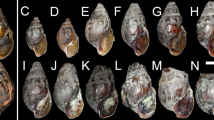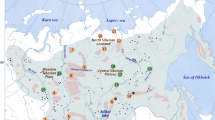Abstract
Using samples of non-native pond sliders (Trachemys scripta) from three different climatic zones in Slovenia, we perform parentage analyses and use population genetic approaches to find out whether they successfully reproduce and are able to establish populations. Based on 14 highly polymorphic microsatellite loci, we provide evidence for successful reproduction and invasiveness of pond sliders not only for the Mediterranean and sub-Mediterranean regions of Slovenia, but also for the central part of the country having a temperate continental climate. Our results suggest that the pond slider should be classified as an invasive species (introduced species spreading in a non-native region) for Slovenia and other European regions with similar climatic conditions. Since the negative impact of pond sliders is out of question for native European turtle species, we suggest the immediate removal of pond sliders from all habitats. Our study provides for the first time hard evidence for the capability of pond sliders to reproduce in Central Europe. Thus, it contributes to the understanding of the invasiveness of pond sliders in Europe and delivers an important foundation for decision-makers in conservation.


Similar content being viewed by others
References
Arvy C, Servan J (1998) Imminent competition between Trachemys scripta and Emys orbicularis in France. Mertensiella 10:33–40
Bonin F (2004) Concordia Turtle Farm—Die größte Rotwangen-Schmuckschildkröten-Farm der USA. Radiata 13:18–24
Bringsøe H (2001) Trachemys scripta (Schoepff, 1792)—Buchstaben-Schmuckschildkröte. In: Fritz U (ed) Handbuch der Reptilien und Amphibien Europas. Vol. 3/IIIa Schildkröten (Testudines) (Bataguridae, Testudinidae, Emydidae). Aula, Wiebelsheim, pp 525–583
Bringsøe H (2006) NOBANIS—Invasive alien species fact sheet, Trachemys scripta. Online database of the North European and Baltic Network on Invasive Alien Species. http://www.nobanis.org. Accessed 29 Jan 2015
Bruekers J, Uijtterschout G, Brouwer A (2006) Erstnachweis einer natürlichen Vermehrung der Rotwangen-Schmuckschildkröte (Trachemys scripta elegans) auf der griechischen Insel Kos. Schildkr Fokus 3(3):29–34
Cadi A, Joly P (2003) Competition for basking places between the endangered European pond turtle (Emys orbicularis galloitalica) and the introduced red-eared slider (Trachemys scripta elegans). Can J Zool 81:1392–1398
Cadi A, Delmas V, Prévot-Julliard AC, Joly P, Pieau C, Girondot M (2004) Successful reproduction of the introduced slider turtle (Trachemys scripta elegans) in the south of France. Aquat Conserv 14:237–246
Case TJ, Bolger DT (1991) The role of introduced species in shaping the distribution and abundance of island reptiles. Evol Ecol 5:272–290
Colautti RI, MacIsaac HJ (2004) A neutral terminology to define ‘invasive’ species. Divers Distrib 10:135–141
Crescente A, Sperone E, Paolillo G, Bernabo I, Brunelli E, Tripepi S (2014) Nesting ecology of the exotic Trachemys scripta elegans in an area of Southern Italy (Angitola Lake, Calabria). Amphibia-Reptilia 35:366–370
Earl DA, vonHoldt BM (2012) structure harvester: a website and program for visualizing structure output and implementing the Evanno method. Conserv Genet Resour 4:359–361
Ernst CH, Lovich JE (2009) Turtles of the United States and Canada, 2nd edn. The Johns Hopkins University Press, Baltimore
Evanno G, Regnaut S, Goudet J (2005) Detecting the number of clusters of individuals using the software structure: a simulation study. Mol Ecol 14:2611–2620
Excoffier L, Lischer HEL (2010) arlequin suite ver 3.5: a new series of programs to perform population genetics analyses under Linux and Windows. Mol Ecol Resour 10:564–567
Ficetola GF, Monti A, Schioppa EP (2002) First records of reproduction of Trachemys scripta in the Po Delta. Ann Mus Civ Stor nat Ferrara 5:125–128
Ficetola GF, Thuiller W, Schioppa EP (2009) From introduction to the establishment of alien species: bioclimatic differences between presence and reproduction localities in the slider turtle. Divers Distrib 15:108–116
Fritz U, Stuckas H, Vargas-Ramírez M, Hundsdörfer AK, Maran J, Päckert M (2012) Molecular phylogeny of Central and South American slider turtles: implications for biogeography and systematics (Testudines: Emydidae: Trachemys). J Zool Syst Evol Res 50:125–136
Gemel R, Marolt M, Ochsenhofer G (2005) Ungewöhnliche “Naturbrut“einer Rotwangen-Schmuckschildkröte (Trachemys scripta elegans) in der Steiermark. ÖGH-Aktuell 15:9–11
Gibbons JW, Scott DE, Ryan TJ, Buhlmann KA, Tuberville TD, Metts BS, Greene JL, Mills T, Leiden Y, Poppy S, Winne CT (2000) The global decline of reptiles, déjà vu amphibians. Bioscience 50:653–666
Glaubitz JC (2004) convert: a user friendly program to reformat diploid genotypic data for commonly used population genetic software packages. Mol Ecol Notes 4:309–310
Goudet J (1995) fstat version 1.2: a computer program to calculate F-statistics. J Hered 86:485–486
Gurevitch J, Padilla DK (2004) Are invasive species a major cause of extinctions? Trends Ecol Evol 19:470–474
Hidalgo-Vila J, Ribas A, Florencio M (2006) Falcaustra donanaensis sp. nov. (Nematoda: Kathlaniidae) a parasite of Mauremys leprosa (Testudines, Bataguridae) in Spain. Parasitol Res 99:410–413
Hubisz MJ, Falush D, Stephens M, Pritchard JK (2009) Inferring weak population structure with the assistance of sample group information. Mol Ecol Resour 9:1322–1332
Kalinowski ST (2004) Counting alleles with rarefaction: private alleles and hierarchical sampling designs. Conserv Genet 5:539–543
Kalinowski ST (2005) hp-rare: a computer program for performing rarefaction on measures of allelic diversity. Mol Ecol Notes 5:187–189
Kalinowski ST, Wagner AP, Taper ML (2006) ml-relate: a computer program for maximum likelihood estimation of relatedness and relationship. Mol Ecol Notes 6:576–579
Kalinowski ST, Taper ML, Marshall TC (2007) Revising how the computer program cervus accommodates genotyping error increases success in paternity assignment. Mol Ecol 16:1099–1106
Kleewein A (2014) First record of reproduction in open land of Trachemys scripta troostii (Holbrook, 1836) with the nominate species Trachemys scripta (Schoepff, 1792) in Austria. Herpetozoa 26:183–185
Krofel M, Cafuta V, Planinc G, Sopotnik M, Šalamun A, Tome S, Vamberger M, Žagar A (2009) Razširjenost plazilcev v Sloveniji: pregled podatkov, zbranih do leta 2009. Natura Sloveniae, Revija za terensko biologijo, J Field Biol 11:61–99
Lowe S, Browne M, Boudjelas S, De Poorter S (2000) 100 of the World’s Worst Invasive Alien Species. A selection from the Global Invasive Species Database. Aliens 12:1–12
Marshall TC, Slate J, Kruuk LEB, Pemberton JM (1998) Statistical confidence for likelihood-based paternity inference in natural populations. Mol Ecol 7:639–655
Martínez-Silvestre A, Soler J, Sole R, Gonzalez FX, Sampere X (1997) Nota sobre la reproducción en condiciones naturales de la Tortuga de Florida (Trachemys scripta elegans) en Masquefa (Catalaña, España). Bol Asoc Herpetol Esp 8:40–42
Meyer L, Du Preez L, Bonneau E, Héritier L, Quintana MF, Valdeón A, Sadaoui A, Kechemir-Issad N, Palacios C, Verneau O (2015) Parasite host-switching from the invasive American red-eared slider, Trachemys scripta elegans, to the native Mediterranean pond turtle, Mauremys leprosa, in natural environments. Aquat Invasions 10:79–91
Mooney HA, Cleland EE (2001) The evolutionary impact of invasive species. PNAS 98:5446–5451
Moravec F, Vargas-Vázquez J (1998) Some endohelminths from the freshwater turtle Trachemys scripta from Yucatán, México. J Nat Hist 32:455–468
Pearson SH, Arvey HW, Spotila JR (2015) Juvenile invasive red-eared slider turtles negatively impact the growth of native turtles: implications for global freshwater turtle populations. Biol Conserv 186:115–121
Pérez-Santigosa N, Díaz-Paniagua C, Hidalgo-Vila J (2008) The reproductive ecology of exotic Trachemys scripta elegans in an invaded area of southern Europe. Aquat Conserv 18:1302–1310
Pérez-Santigosa N, Florencio M, Hidalgo-Vila J, Díaz-Paniagua C (2011) Does the exotic invader turtle, Trachemys scripta elegans, compete for food with coexisting native turtles? Amphibia-Reptilia 32:167–175
Phillips BL, Shine R (2006) An invasive species induces rapid adaptive change in a native predator: cane toads and black snakes in Australia. Proc R Soc B-Biol Sci 273:1545–1550
Phillips BL, Brown GP, Webb JK, Shine R (2006) Invasion and the evolution of speed in toads. Nature 439:803
Pieh A, Laufer H (2006) Die Rotwangen-Schmuckschildkröte (Trachemys scripta elegans) in Baden-Württemberg—mit Hinweis auf eine Reproduktion im Freiland. Z Feldherpetol 13:225–234
Pritchard JK, Stephens M, Donnelly P (2000) Inference of population structure using multilocus genotype data. Genetics 155:945–959
Randi E (2008) Detecting hybridization between wild species and their domesticated relatives. Mol Ecol 17:285–293
Rataj AV, Lindtner-Knific R, Vlahović K, Mavri U, Dovč A (2011) Parasites in pet reptiles. Acta Vet Scand 53:33
Rosenberg NA (2004) distruct: a program for the graphical display of population structure. Mol Ecol Notes 4:137–138
Shen L, Shi H, Wang R, Liu D, Pang X (2011) An invasive species red-eared slider (Trachemys scripta elegans) carrying Salmonella pathogens in Hainan island. Mol Pathogen 2:4
Simberloff D (2003) Confronting introduced species: a form of xenophobia? Biol Invasions 5:179–192
Simison WB, Sellas AB, Feldheim KA, Parham JF (2013) Isolation and characterization of microsatellite markers for identifying hybridization and genetic pollution associated with red-eared slider turtles (Trachemys scripta elegans). Conserv Genet Resour 5:1139–1140
Vamberger M (2009) European pond turtle (Emys orbicularis) in Slovenia. In: Rogner M (ed) European pond turtle (Emys orbicularis). Edition Chimaira, Frankfurt am Main, pp 191–193
Vamberger M (2012) Želvica, želva, brezdomka? Temporaria 11:12–15
Vamberger M, Lipovšek G, Gregorič M (2012) First reproduction record of Trachemys scripta (Schoepff, 1792), in Slovenia. Herpetozoa 25:76–79
van Oosterhout C, Hutchinson WF, Wills DPM, Shipley P (2004) micro-checker: software for identifying and correcting genotyping errors in microsatellite data. Mol Ecol Notes 4:535–538
Wüthrich F (2004) Naturbruten im Jahr 2003 in der Schweiz. Testudo 13:5–20
Acknowledgments
This study was partially funded from Mestna občina Ljubljana by supporting the project “Izboljšanje habitata močvirske sklednice v Krajinskem parku Tivoli, Rožnik in Šišenski hrib 2014”, which was carried out by the society “Herpetološko društvo – Societas Herpetologica Slovenica”. We would like to thank Anke Müller for help with field work, Katarina Lipovšek, Lara Lipovšek, Marjetka Šemrl, Daniela Vlačič, Irena and Ciril Hanžič for accommodation and care during fieldwork, Marijan Govedič and Ali Šalamun from the Centre for Cartography of Fauna and Flora (CKFF) for the traps, logistic support and making maps of Slovenia. Special thanks also to Rastislav Pogelšek from Sport Fishing Club Renče.
Author information
Authors and Affiliations
Corresponding author
Electronic supplementary material
Below is the link to the electronic supplementary material.
Rights and permissions
About this article
Cite this article
Standfuss, B., Lipovšek, G., Fritz, U. et al. Threat or fiction: is the pond slider (Trachemys scripta) really invasive in Central Europe? A case study from Slovenia. Conserv Genet 17, 557–563 (2016). https://doi.org/10.1007/s10592-015-0805-2
Received:
Accepted:
Published:
Issue Date:
DOI: https://doi.org/10.1007/s10592-015-0805-2




